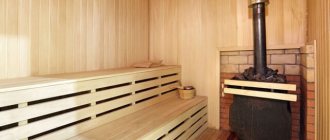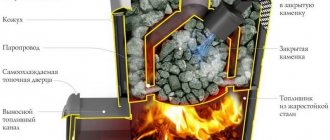A good electric stove for a bath or sauna will allow you to comfortably set up both a home and commercial steam room. There are many similar devices on the market today in different variations and price groups, therefore, choosing the right one (even from a budget series) will not be difficult. Moreover, it is not necessary that a cheap device will be deprived of most additional options. The stove devices under consideration can be used not only for heating steam rooms, but also for heating water. Typically, the designs of modern electric furnaces have a double casing, inside of which heating elements are located. In the upper part of the apparatus, a cage or tray is installed where bath stones are placed. The heating rate of the entire steam room will directly depend on their number and placement, because the heated stone immediately begins to transfer its heat to the external environment. Today's electric ovens can be installed either on the floor or hung on the wall. Most often, their control is controlled using a remote control.
Wood-burning or electric stove for a bath: what to take?
Well, if we are not talking about a stove that will be in an apartment or house, then the choice is really relevant. A wood-burning or electric sauna stove has its advantages, as well as disadvantages, and by weighing them, you can come to a thoughtful decision.
Electric heaters are easier to maintain , wood-burning ones will require the skills of a stoker, and also guarantee constant concern about the condition of the ash pan, chimney, replenishment of firewood and other chores.
But electricity is much more expensive than firewood , and installing a sauna stove requires inviting a professional electrician , who can tell you that your wiring is unsuitable and needs to be replaced. (Of course, this does not always happen.)
By the way, to find out which of the stoves - 220 volts or 380 - is suitable in your case, we recommend reading this article.
Arrangement of a sauna also requires the creation of a grounding loop , and some of the work must be carried out at the construction stage - laying a mesh on the waterproofing, edging the perimeter with a steel strip to which the mesh is welded, and then connecting the structure to the zero on the panel.
A wood stove will require, at a minimum, the construction of a foundation , and at a maximum, a separate foundation. In addition, the correct installation of a chimney is also not an easy task . In the case of a remote firebox, you will also have to build a fire-resistant wall .
Thus, in no case will it be completely without difficulties , but we agree to some things easier, so the decision about which stove will be in your steam room is yours. We only advise you to read our article, which provides more food for thought about different types of sauna stoves.
And for those who are strongly inclined to purchase an electric stove for a bath , we advise you to read the article about the intricacies of its choice and this short review of electric stoves.
Furnace installation
Furnace installation rules
- An electric sauna heater can be installed either in the corner of the room or in its center.
- It must be installed on the floor or a flat base using special bolts that are included in the kit.
- When fastening, you must maintain the clearances specified in the instructions.
- Only 1 stove can be installed in the steam room.
- The surface of the walls behind the stove must be covered with a thermal protective screen. Light protection, for example, asbestos boards, is absolutely not suitable for this.
Thermal shield on the wall
Network connection
- The connection must be made using heat-resistant wires in a sleeve through a separate circuit breaker with a residual current device.
- To do this, you can use rubber-wrapped wires, for example A07BB (VSB) or H07RN (VSN), but in no case with PVC insulation. The table contains data for calculating the power and number of fuses and wire cross-section.
Power calculation table for electric oven
- All control elements, switches, distribution boxes are moved to another room. In the sauna itself, only the heating element and thermostat sensor remain.
- The temperature sensor is mounted next to the stove in accordance with the manufacturer's recommendations. The sensor wire cannot be extended using ordinary wires.
- Using a sensor, heating operation will be suspended when the dangerous temperature is exceeded. Therefore, it is important to install it correctly.
- As an additional measure of protection, it is recommended to use a fire extinguishing system.
Stones for the stove
Laying stones
- Large stones are laid down, and small ones on top. Do not pack them too tightly or forcefully, otherwise air circulation will be impaired. The heating elements must be securely covered with stones. You cannot turn on the stove without stones.
- Once a year, go through the stones: clean them and remove small crushed stones so that heat exchange is not disturbed. But you can’t load the first cobblestones you come across instead: this can not only reduce the efficiency of heating, but also become harmful to health.
Advice! The stones must withstand the heat and high temperature changes that evaporating water creates. They should not crack or emit odor when exposed to high temperatures. Usually a basic set of stones is included.
Is an electric stove suitable for a Russian bath?
We have already said that the traditions of the Russian bath are not yet forgotten in our country, so it is quite reasonable to ask whether it is possible to take a normal steam bath with an electric sauna heater?
Traditionalists , as a matter of course, will say that no, this is impossible . In fact, electric stoves were invented for saunas. And what they do best is to maintain the Finnish bath mode, that is, to dry the air and heat it to very high temperatures using high convection.
In a real Russian bath, the temperature should be lower and the humidity should be higher, and the humidity should come from good, light steam obtained from overheated stones. And those stones that lie in the open heater of the sauna stove cannot heat up to the required temperatures . If the stove is also electric, then it must be protected from excess water, which can damage the heating elements - heating elements located between the stones.
The photo shows heating elements for electric heaters, red-hot.
The problem of steam generation in a sauna with an electric heater is usually solved with the help of a steam generator - built-in or separate. We recommend that you read the article that examines this issue in detail. Here we will say that there are different types of steam generators - some produce heavy white steam, which has nothing in common with what is needed in a Russian steam room, others cope well with the task of creating finely dispersed steam - you need to find out about this at the purchase stage.
CONCLUSION! So, using an electric oven to create the conditions of a Russian bathhouse to the fullest extent is impossible, but with a good steam generator it will still be possible to steam, the main thing is to keep the temperature around 65 degrees and give more steam.
It remains to be seen which models of electric stoves for Russian baths are best suited for the task.
Advantages and disadvantages
The advantages of electric furnaces for heating saunas and baths include:
- Quick heating of the room and stable maintenance of the temperature in it.
- You can choose a model that is compact in size.
- Unlike gas furnaces, there is no need to coordinate the installation of the device.
- Quick and easy installation of equipment.
- There is no need to organize firewood storage.
- Such a stove operates without a chimney.
- Easy to manage, maintain and operate.
- Availability of built-in fuse against overheating.
- Reliable thermal insulation guarantees the safety of using the electric furnace.
- There is no carbon monoxide emission during operation.
Among the disadvantages are:
- The high cost of electrical energy does not allow using the bathhouse for procedures too often and for a long time.
- It is not always possible to install a powerful stove due to power limitations in the electrical network in a private residential building in the range from 4 to 6 kW.
- Compared to devices running on wood or natural gas, the heating power of electric furnaces may be lower.
Electric heater for a Russian bath: what is on the market?
Finnish steam generators are mainly designed to produce heavy steam. But Russian ones, on the contrary, are specially made for those who are looking for a compromise between the speed of preparation for procedures and the Russian steam room. Therefore, we recommend that you pay attention to domestic products if we are talking about a more or less budget option , or buy expensive Finnish models with closed heaters, which will be discussed in the next subheading.
Here are examples of Russian electric sauna heaters with steam generators:
"Teplodar"
- SteamCartridge (separate)
- SteamCity (separate)
"Polytech"
- "Christina" with ENU evaporator (from 12I to 18I)
Electric stove for a Russian bath with a closed heater - the optimal solution, limited choice
Many people know that proper steam can only be obtained in a closed heater, but this is only true for wood-burning stoves . And here's why: heating stones to high temperatures (over 400 degrees) is impossible if the stones are lying openly, with access to air.
In this case, they will heat up to 200-250 degrees from above. This means that you add water once and they will cool down, and the steam will not be of the best quality. Only stones superheated in a closed volume will produce finely dispersed steam, which is what is needed in a Russian bath.
A closed heater is placed in the firebox, closer to the fire that washes it. There is nothing like this in an electric stove - it is a bowl with heaters that convert electricity into thermal energy. Heat is transferred from the heaters to the stones.
If the heater is open, then what is said about the temperature of the upper stones applies to it. But there are also closed electric heaters. And the task that is primarily assigned to the lid in such an oven is to stop convection.
Electric heater-thermos
The fact is that the heating rate of the steam room directly depends on how quickly the stove can transfer heat to the air. If there is a constant flow through it, the process goes quickly. But in a Russian steam room, it is customary to stop convection (heat flow) in order to create a “steam cake” under the ceiling. A lid on an electric stove is a way to stop convection.
But whether it is possible to get good steam from a closed electric heater is a question of the number of stones and the power of the stove. The more powerful the furnace, the more it heats the stones. The more stones there are, the less likely it is to damage the heaters by flooding them with water.
However, a powerful stove is only suitable for a sufficiently large steam room. Therefore, the creators of electric stoves took a different route - they used electricity to convert water into steam separately from stones.
ADVICE! For those who have a small steam room, it is better to buy stoves with steam generators (combi or separate).
The best option today among electric stoves for a Russian bath with a closed heater would be the so-called “thermos” stoves, similar to the following models:
- Harvia Forte;
- Harvia Symphony;
- Helo 18 UKKOTONTTU
Warning! “Thermoses” are expensive, more than 100 thousand. However, these electric stoves are quite suitable for a Russian bath, because they allow you to get high-quality steam from the stones.
Types and types of tank placement
There are two types of stoves with tanks based on materials::
- Metal . Made from cast iron or stainless steel. Manufacturers offer square, rectangular, cylindrical and other units. The devices are inexpensive and do not require a foundation. The disadvantage is poor resistance to temperature changes.
- Brick . A practical option. They retain heat for a long time and have a long service life. To install them, it is necessary to build a reliable foundation.
Tanks for sauna stoves come in the following types::
- Remote . One of the most optimal locations. This allows you to quickly heat the water and maintain the desired temperature in the steam room. Moisture does not spread until it warms up. Most people place the tank in an adjacent room and connect a register so that the water is heated by the stove.
- Built-in . The reservoir is installed above the firebox or on the side of the stove. The shape of the container is most often rectangular. In this case, the wall thickness is 0.8-1.5 cm. The reservoir is filled with water through a special hole. You have to regularly pour hot water into the tanks and add cold water, since they do not tolerate temperature changes well.
- Mounted . An airtight container with a lid and a tap to drain the water. Installed on one of the walls of the stove. Usually made of stainless steel, as this material can withstand heavy loads. The container is attached to the oven wall using hooks or loops. It is convenient to install and remove. This option is great for small baths.
- Added . Original view of the bank. The pipe is welded at an angle from the stove to the bottom of the tank. The container is placed above the stove. Heating occurs as follows: liquid from the bottom passes into an inclined pipe and boils. Bubbles form, rise up the pipe and burst when they find themselves in cold water. In this way, heat is transferred and convection is formed.
- Chimney (samovar) . One of the most common, but not the most practical tanks. Hot air passes through a pipe in the center of the body and heats the water. Reservoirs come in a variety of shapes. The main disadvantage is the location. It is inconvenient to fill in water, since the filler hole is located high.
Mandatory and optional components of an electric sauna stove
After the article mentioned heating elements more than once, it’s time to clarify what they are, which ones are better, and what else is included with electric stoves.
Heating elements for electric heaters
A heating element is a tubular electric heater ; it is found not only in heaters, but also in washing machines and kettles. This is a spiral in a durable shell - a tube, usually made of stainless metal.
Heating elements are relatively cheap , but at the same time they are very fragile , especially when they are in the open state, as in heaters. When laying stones, they can be damaged. Filling them with water can ruin them. And yet most manufacturers still include them in their products.
However they have an alternative:
Electric heaters with band heaters
Tape heaters have two advantages: they are stronger and more economical than their predecessors. Cost-effectiveness is expressed in the fact that, with equal power to heating elements, tape heaters heat 1.5 times more volume , and strength lies in the fact that it is much more difficult to damage them, because the heaters are located inside the ceramic tape.
Electric heater with tape heaters. Photo source
The cost of electric heaters with tape heaters may be higher, but they are still somewhere in the middle price category ; there are heaters with heating elements that are much more expensive.
Electric heater control panel
Models with two modifications are often found on sale: built-in and remote control panel . In the first case, all buttons and knobs will be located on the body, in the second - on a separate remote control.
Electric heater control panel
Standard features include temperature control, the ability to delay start up to 9 hours, and the ability to automatically turn off after a set period of time . If the heater has a steam generator , then there is humidity .
More remote controls for electric heaters
Electric sauna stove with water tank
Sometimes Internet users search online for an electric furnace with a water tank. Here we will disappoint them. When it comes to a water tank in a bathhouse , it usually means that there is no connection to a hot water supply, so you have to heat the water yourself for the needs of the washing room (we have detailed information about such stoves). However, this does not work for electric sauna stoves: yes, they also come with water tanks, but we are talking about models with steam generators that need this water to create steam. We simply didn’t find any other options!
How to choose a stove depending on the volume of the room
When choosing a heater on the manufacturer’s website, it is recommended to look at the technical characteristics of the device. For example, there are models of stoves with a power of 9 kW, which are designed to heat 8-14 m3.
Electric heater in a small room
To calculate the power of the heater, you need to calculate the volume of the room. Furnaces equipped with heating elements heat 1 m3 with one kW, and belt furnaces heat 1.5 m3. In addition, 1 m3 is added to the calculated volume for every 1 m2 of non-thermal insulated surface, for example, if the door is made of glass, then 1.5 m3 is added. You should not take a stove whose maximum power will be equal to the calculated one, since operation at increased loads will quickly render it unusable.
Manufacturers of electric furnaces for baths
In order not to lump everything into a heap, we have divided the manufacturers of electric stoves for baths into domestic and foreign ones. In cases where entire articles are devoted to groups or individual manufacturers, brief information is provided here.
Domestic electric heaters for baths
Among them, it is worth mentioning the company "Polytech", which produces various stoves under the general name "Christina", varying only the second part of the name. The advantages of its heaters include the relatively low cost and the presence of strip heaters, the advantages of which were discussed above.
There are other manufacturers of electric furnaces for baths who supply strip heaters - these are Ermak and Elektropech . In addition, they are found in Vesta ovens, the manufacturer of which remains unknown to us. In all cases the price is moderate .
For a more complete overview of the most popular Russian heaters, we recommend reading the article at the link provided.
Video on topic
A video that talks about two Christina stoves of different power:
Foreign electric heaters
People in Russia are most familiar with Finnish-made heaters. And they really are the majority among the products of foreign companies represented on our market.
In this regard, we devoted several articles to Finnish electric stoves: a review of different companies, which, by the way, included the Swedish Tylo, which recently merged with the Finns, as well as two articles about the most popular company in Russia, Harvia - a review of the stoves of this companies and an article to help those who want to know whether Harvia is suitable for their steam room.
Video on topic
Video about the range of electric furnaces ]SAWO[/anchor]:
In addition to the Finns, you can also find German-made electric furnaces on the market, in particular from EOS.
Electric heater EOS
A characteristic feature of EOS stoves is that the company does not rely on attractive appearance, believing that strength and reliability are attractive in themselves. Therefore, there are relatively few cheap stoves in their model range, and among the expensive ones you can find such a refinement of design thought as a mill wheel that supplies water to a red-hot metal pyramid. Well, everything here is for everyone.
Therefore, we will risk expressing our own opinion: if durability is important to the buyer, EOS electric furnaces are quite suitable for him, even in the angular design that is typical of most models. Everything else, in essence, doesn’t matter. By the way, strange-looking cylindrical models appeared at last year’s exhibitions - Zeus and Orbit, for example. But they still lack grace.
EOS electric heaters are available in floor-mounted, wall-mounted and under-counter versions . Power varies within average limits: from 2 to 12 kW. Some models are equipped with steam generators .
IMPORTANT! It is worth paying attention to the network requirements - there are models that require non-standard 400 volts.
Reviews
Of course, we are all tired of advertising and want information that comes directly from users. But it has long been the subject of falsification, so let’s proceed from common sense: in general, reviews of the electric heater will be positive from those who received exactly what they wanted - either a sauna stove, or that rare variety that allows you to arrange a sauna “in Russians." And if you want more detailed information, take a look at the articles that are devoted to specific models, where reviews will concern both real advantages and real disadvantages.
Problem: the electric heater is humming
We can assume that the reason your electric heater is humming is due to an increase in air draft (this happens in chimneys). All electric furnaces have holes at the bottom for the intake of cold air, which flows to the heated stones, and from there goes upward with force. The upward movement of lighter hot air creates draft. It may be more or less, depending on the temperature difference .
Of course, the cause of the hum may also be a malfunction of the device. In this case, you should contact a specialist or service center.











